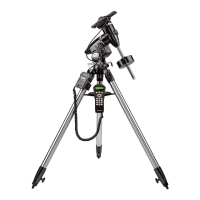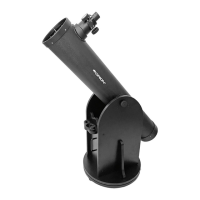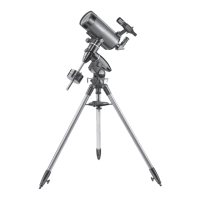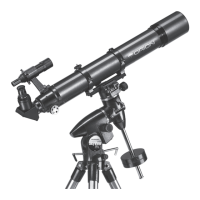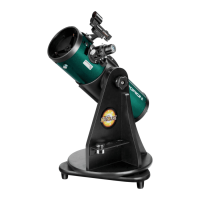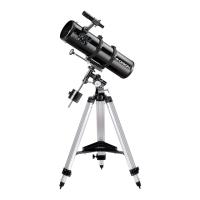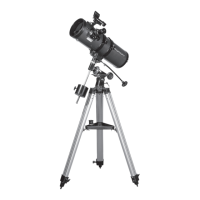10
3. The GoTo
Hand Controller
The SkyQuest XTg features the SynScan hand controller,
which contains a database of stars, deep-sky objects, and
solar system denizens – nearly 43,000 in all. The features and
functionality of the SynScan controller are covered in detail in
a separate manual entitled SynScan GoTo Hand Controller.
Please refer to that manual before beginning your explora-
tions with the SkyQuest XTg.
4. Collimating the
Optical System
To get the sharpest images, your telescope’s optical sys-
tem must be in precise alignment. The process of aligning
the primary and secondary mirrors with each other and with
the mechanical axis of the telescope is called collimating.
Collimating is relatively easy to do and can be done in day-
light or at night.
Because the primary mirror is shipped separately from the
optical tube, the telescope’s optics must be collimated before
it can be used. Most of the adjustments will be to the tilt of the
primary mirror, as the secondary mirror has been pre-aligned
at the factory. It is also good idea to check the collimation
(optical alignment) of your telescope before each observing
session and make any necessary adjustments.
To check collimation, remove the eyepiece and look down the
focuser drawtube. You should see the secondary mirror cen-
tered in the drawtube, as well as the reflection of the primary
mirror centered in the secondary mirror, and the reflection of
the secondary mirror (and your eye) centered in the reflection
of the primary mirror, as depicted in Figure 22a. If anything
is off-center, as in Figure 22b, proceed with the following col-
limation procedure.
The Collimation Cap and Mirror Center Mark
Your XTg comes with a collimation cap. This is a simple cap
that fits on the focuser drawtube like a dust cap, but has a
hole in the center and a reflective inner surface. The cap
helps center your eye so that collimating is easier to perform.
Figures 22b-e assume you have the collimation cap in place.
As an additional aid in collimating, the primary mirror of the
XTg has a tiny adhesive ring marking its exact center. This
center ring will not affect the images you see when observ-
ing with the telescope in any way (since it lies directly in the
shadow of the secondary mirror), but it will greatly facilitate
collimating when using the supplied collimation cap or other,
more sophisticated collimation devices, such as the Orion
LaserMate Deluxe II Laser Collimator.
Preparing the Telescope for Collimating
Once you get the hang of collimating, you will be able to do it
quickly even in the dark. For now, it is best to collimate in day-
Figure 22. Collimating the optics. (a) When the mirrors are properly aligned, the view down the focuser drawtube should
look like this.
(b) With the collimation cap in place, if the optics are out of alignment, the view might look something like this.
(c) Here, the secondary mirror is centered under the focuser, but it needs to be adjusted (tilted) so that the entire primary
mirror is visible.
(d) The secondary mirror is correctly aligned, but the primary mirror still needs adjustment. When the primary
mirror is correctly aligned, the “dot” will be centered, as in
(e).
a.
e.
d.
c.
b.
Note: 10" model has 4 mirror clips

